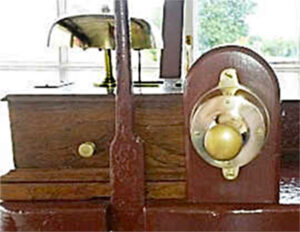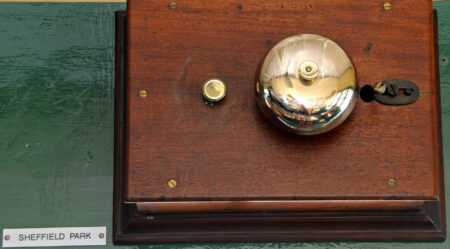
One of the “sounds” of the railways of yesteryear was the ringing of bells.
Bells were a very important form of communication and were used extensively for the signalman to communicate quickly and efficiently with both his fellow signalmen and, if sited at a station, the platform staff. Probably the most frequent to be heard by visitors to Bluebell stations are the platform bells. By this means the signalman can inform the station staff of various matters they need to know. In a couple of seconds he can send his message which will be heard by all those on the station, saving the need for someone to answer a telephone and pass the message on. The type of message sent this way will be to inform that an expected train has entered the block section, later that its arrival is imminent and, where appropriate, which platform it will arrive in. A further use of the platform bell is to quickly summon someone to attend the signalbox, should that be necessary.
Platform bell signals |
Bell code |
|---|---|
| Train left Sheffield Park for Horsted Keynes (bells at HK) | 3-1 |
| Train left Horsted Keynes for Sheffield Park (bells at SP) | 3 |
| Train left Kingscote for Horsted Keynes (bells at HK) | 1-3 |
| Train left Horsted Keynes for Kingscote (bells at KC) | 3 |
| Train approaching – platform 1 Sheffield Park | 1 |
| Train approaching – platform 2 Sheffield Park | 2 |
| Train approaching – platform 2 Horsted Keynes | 2 |
| Train approaching – platform 3 Horsted Keynes | 3 |
| Train approaching – platform 4/5 Horsted Keynes | 4 |
| Train approaching – main platform Kingscote | 1 |
| Train approaching – loop platform Kingscote | 2 |
| Attend at Signalbox | 6 |
The main use of the bells however is for box to box communication to assist in the passage of trains from one block post to the next. The bell codes used on the Bluebell are a reduced selection from those used by the Southern Railway, amended in places for our own circumstances, and are as follows:
Description of bell signal |
Bell code |
|
|---|---|---|
| Call attention | 1 | |
| Is line clear for… | Passenger train | 3-1 |
| Pullman train | 4-2-1 | |
| Empty coaching stock | 2-2-1 | |
| Goods or Through Engineer’s train | 3-2 | |
| Light engine(s) | 4-1 | |
| Engine and brake van | 1-1-3 | |
| Engineer’s train requiring to stop in section | 5 | |
| Trolley or Permanent-Way Machine | Through section | 1-2-1 |
| Stopping in section | 1-3-1 | |
| Train entering section | 2 | |
| Bank engine in rear of train | 1-4-1 | |
| Train out of section or Obstruction removed | 2-1 | |
| Obstruction danger | 6 | |
| Release token for shunting | 5-2 | |
| Shunting completed – token replaced | 2-5 | |
| Stop and examine train | 7 | |
| Cancelling “is line clear” or “train entering section” | 3-5 | |
| Last train signalled incorrectly described | 5-3 | |
| Train passed without tail lamp | To Box in Advance | 9 |
| To Box in Rear | 4-5 | |
| Train divided | 5-5 | |
| Train or Vehicles running away | 2-5-5 | |
| Opening of signal box | 5-5-5 | |
| Closing of signal box | 7-5-5 | |
| Closing of signal box where Section Signal is locked by the Block | 5-5-7 | |
| Testing Block instruments and bells | 16 | |
| Transference of tokens by lineman | 4-4-4-4 |
It goes without saying that some of these are not used, but are there on a “just-in-case” basis in the unlikely event an emergency should occur.

Further explanation
Most of these are self-explanatory. Where the closing of the signalbox is concerned, the 7-5-5 covers both when the box is going to be “switched out” (with a train about to enter the section) so that a token can be obtained (by remote release) at the other end of the section following the departure of the train from that section and where the box is simply closed but not “switched out”. 5-5-7 applies where there is nothing in section and the box is to be “switched out” necessitating the signalman at the other end of the section providing a release so that the closing signalman can obtain a staff or token in order to pull off his signals prior to “switching out”. When a signalman sends a signal to his colleague in the adjacent box, that colleague will acknowledge the signal by repeating it back to the first signalman, provided he is able. Before a train can enter a section of track the signalman sending it has to obtain permission for it to enter the section from the box ahead, which permission is given by the act of the other signalman repeating the signal – obviously if he cannot accept the train, he will not repeat the signal back again.

The “Call Attention” is self-explanatory but we do not use it when one signal follows on immediately from another. For example, when a train has safely cleared the section the receiving signalman will send “Train Out of Section” to the despatching signalman, which will be acknowledged by repetition. If either signalman then needs to send a train to the other, he will simply use the signal for the type of train he is sending. Let’s follow an 11am departure from Sheffield Park to Kingscote:
Assuming all is well and the train will be ready to leave on time the SP signalman will, approximately 10 to 15 minutes before departure time, ask for permission to send the train to Horsted Keynes (provided nothing is occupying the section!) by first sending one beat on his bell, then once he has had the acknowledgement from HK will request permission by sending three beats followed by one beat. The signalman at HK will accept the train by sending three beats followed by one beat and will then allow the signalman at SP to withdraw a single line token by sending him an electrical release from the token instrument in HK box. The SP signalman can now pull off his starting signals, hand the token to the driver and return to his box to await departure time. As soon as the train starts to move he will send two beats on his bell to HK where the signalman will return the two beats to SP, send three beats and one beat on his platform bell to tell the staff there that the train has left SP and then, if nothing is in section between HK and Kingscote, will send one beat to the KC signalman.
The process repeats itself with the KC signalman responding with one beat, the HK signalman requesting permission with three beats and one beat, the KC signalman accepting with three beats and one beat and then allowing the HK signalman to withdraw a single line token by means of the electrical release from the instrument in KC box. The HK signalman can now pull off his signals and will await arrival of the train, due at 11.15am. Shortly before it arrives he will be advised of its approach by an audible warning in the box and will send send the appropriate number of beats on the platform bell to advise the staff there that the train is approaching a platform. When it arrives he will go down to meet it and exchange the SP-HK token for the HK-KC token, return to his box and, as the tail of the train passes him, look to see it is complete by checking for the tail lamp. Assuming everything to be in order he will replace his approach signals, replace the token in the instrument and send two beats and one beat to SP, waiting to hear the similar response.
By now it will be approaching 11.17am and time for the train to depart to KC. As soon as it moves he will send two beats to the KC signalman. The KC signalman will return two beats, send three beats on his platform bell and then pull off his signals and await the arrival of the train, due at 11.30am. When he sees the train approaching on the track circuits on the box’s panel, he will send one beat on the platform bell and then, as it stops in the station near his box will collect the token, and pass the driver the token for the section northwards to East Grinstead (there is no box there, this section of the line being under the control, remotely, from the KC Box). Returning to his box, he will replace his signals, return the token to the instrument and send two beats and one beat to HK. After setting the signals for departure to East Grinstead, he will check, as it departs to see the train is complete, and warn the platform staff at EG that the train is on its way. The whole process then continues in similar fashion throughout the timetable.
Other bells we use are Shunting bells. At Horsted Keynes, when a movement is made into the down sidings at Horsted Keynes a lever in the box is pulled to strike beats on a bell situated close to the entrance to the sidings in order to warn anyone in the proximity of the movement. Most shunting bell uses at Sheffield Park have been replaced by telephones but we still use one for the signalman to acknowledge the instructions the running foreman may have sent by means of the Walkers Train Describer, a clockwork instrument with an arm that rotates on the face of a dial marked with the various movements that may be required. When it does so it sends an electrical impulse to a similar instrument in the signalbox which then repeats the required movement.



